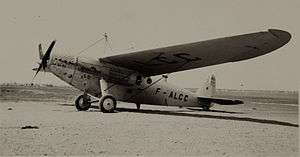Blériot 110
| Blériot 110 | |
|---|---|
 | |
| Role | Long-distance research aircraft |
| Manufacturer | Blériot Aéronautique |
| Designer | Filippo Zappata |
| First flight | 16 May 1930 |
| Number built | 1 |
|
| |
The Blériot 110 (or Blériot-Zappata 110) was a French aircraft intended to attempt new world aerial distance records in 1930.
Design and development
It was built specifically at the request of the French government and was a large high-wing cantilever monoplane. For its long-distance mission, it was equipped with six fuel tanks in the wings and four in the fuselage to hold a total of 6,000 L (1,319 Imperial gallons or 1,585 US gal). Because the pilot and co-pilots seats were behind the huge fuselage fuel cells, a unique mirror system was provided for take-offs and landings. Also a sleeping couch was provided behind the co-pilot's station so one of the two crew members could sleep on long-distance flights.[1]
The aircraft's first flight on 16 May 1930 was cut short by a fuel supply problem, although no damage was sustained. After repairs, it was taken to Oran, Algeria, to make attempts on the closed-circuit distance record. Between 15 November and 26 March 1932, the Blériot 110, with pilots Lucien Bossoutrot and Maurice Rossi, broke this record three times; the final occasion staying aloft for 76 hours 34 minutes and covering a distance of 10,601 km (6,587 mi). By this time, the aircraft had been named Joseph Le Brix in honour of the aviator who had perished flying the 110's rival Dewoitine D.33.
On 5 August 1933, Paul Codos and Maurice Rossi set a new straight-line distance record, flying from New York to Rayak, Syria - a distance of 9,105 km (5,658 mi). Further records were attempted over the next two years, but when all proved unsuccessful, the 110 was scrapped.
Specifications
General characteristics
- Crew: two pilots
- Length: 14.57 m (47 ft 9 in)
- Wingspan: 26.50 m (86 ft 11 in)
- Height: 4.90 m (16 ft 1 in)
- Wing area: 81.0 m2 (872 ft2)
- Empty weight: 2,680 kg (5,808 lb)
- Gross weight: 8,790 kg (19,378 lb)
- Powerplant: 1 × Hispano-Suiza 12L, 447 kW (600 hp)
Performance
- Maximum speed: 220 km/h (137 mph)
- Range: 12,600 km (7,830 miles)
- Service ceiling: 2,000 m (6,560 ft)
See also
- Aircraft of comparable role, configuration and era
References
| Wikimedia Commons has media related to Blériot 110. |
- Notes
- ↑ "Mirrors Help Record Ship Take-Off and Land." Popular Mechanic, December 1933, p. 807.
- Bibliography
- Taylor, Michael J. H. (1989). Jane's Encyclopedia of Aviation. London: Studio Editions. p. 162.
- World Aircraft Information Files. London: Bright Star Publishing. pp. File 890 Sheet 41.